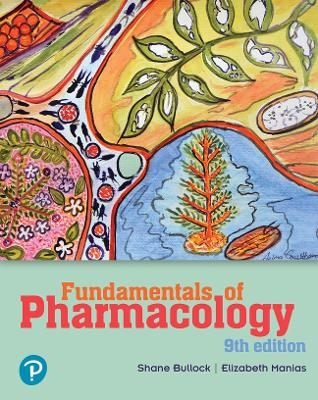
Fundamentals of Pharmacology
Pearson (Verlag)
978-0-6557-0247-4 (ISBN)
- Titel nicht im Sortiment
- Artikel merken
It is designed to establish a foundational knowledge of pharmacology - the study of drug and medication actions and interactions. Students of other health disciplines whose roles involve pharmacological therapy (such as pharmacy, podiatry, optometry, paramedic and physiotherapy), as well as those studying basic science, should find much of the material relevant to their studies. Qualified health professionals may also find this textbook useful as a part of their continuing professional education and postgraduate studies.
Philosophically, our goal is to empower health professionals through an understanding of the fundamental scientific principles of pharmacology that inform clinical practice. To promote understanding, we believe that the effects of medicines on physiological and pathophysiological processes have to be clearly explained. We have included a small amount of chemistry and biochemistry where appropriate to facilitate this understanding. With a greater appreciation of the action of medicines and their target tissues, the reader should be able to deduce what therapeutic and adverse effects to expect, as well as the precautions and contraindications to consider. We have sought to balance the pharmacology content with considerations associated with clinical practice in the most readable way.
Where possible, we have tended to describe the important characteristics of medicine groupings rather than focus on individual agents. We have used prototypes and common generics as examples. The rationale for this approach is that new medicines are regularly entering the market while older agents are removed. The average practitioner cannot possibly keep up with all these changes. However, if a student knows which grouping a new agent belongs to, the principal characteristics of the medicine can be easily deduced.
Samples Download the table of contents >
Preview sample pages from Fundamentals of Pharmacology >
Professor Shane Bullock has been involved in the education of health professionals and science students for more than 30 years. He is currently the Head of the Monash University School of Rural Health, involved in rural health workforce preparation and development. Shane is the co-author of two Australian textbooks, Fundamentals of Pharmacology, now in its 9th edition, and Psychopharmacology for Health Professionals. He has also published a number of journal articles on health professional education and health service delivery. Elizabeth Manias is a registered nurse and a pharmacist. Her areas of interest include medication safety, medication adherence, communication processes between health professionals, patients and family members, and patient safety and risk management. Her work also involves examining organisational and environmental aspects of patient safety, and consumer participation in care. She employs diverse research methodologies when undertaking research, including interventional studies, ethnographic approaches, clinical audits and the validation of risk assessment tools. Elizabeth is very passionate about developing, testing and implementing practices aimed at improving patient safety, and facilitating patient and family engagement in health care. She also enjoys working with clinicians to improve healthcare. Elizabeth is an advocate for supporting students in their learning to facilitate high quality patient care.
SECTION I AN INTRODUCTION TO SOCIOCULTURAL ASPECTS, LAW AND ETHICS
1 Sociocultural aspects
2 Health professionals and the law
3 Ethical issues in health care
SECTION II MEDICINE ADMINISTRATION AND PROFESSIONAL RESPONSIBILITIES
4 Medicine formulations, storage and routes of administration
5 The clinical decision-making process
6 Medicine administration strategies and documentation
7 Medication errors
SECTION III GENERAL ASPECTS OF PHARMACOLOGY
8 Drug nomenclature
9 Pharmacokinetics
10 Pharmacodynamics
11 Pharmacogenetics
12 Drug interactions
13 Pharmacokinetic factors that modify drug action
14 Paediatric and geriatric pharmacology
SECTION IV TOXICOLOGY
15 Poisoning and envenomation
16 The management of acute clinical overdose
17 Contemporary substances of abuse
18 Medicine safety
SECTION V AUTONOMIC PHARMACOLOGY
19 General aspects of neuropharmacology
20 Adrenergic pharmacology
21 Cholinergic pharmacology
SECTION VI NEUROPHARMACOLOGY
22 Antipsychotic agents
23 Anxiolytics and hypnotics
24 Antidepressants and mood stabilisers
25 Neurodegenerative disorders
26 Antiseizure agents and muscle relaxants
27 Central nervous system stimulants
SECTION VII PAIN AND ANAESTHESIA
28 Analgesics
29 Migraine and other headaches
30 General anaesthesia
31 Local anaesthesia
SECTION VIII INFLAMMATION, IMMUNITY AND CANCER
32 Anti-inflammatory agents
33 Antigout medicines
34 Antihistamines
35 Immunomodulating agents
36 Cancer chemotherapy
SECTION IX CARDIOVASCULAR AND RESPIRATORY PHARMACOLOGY
37 Dyslipidaemia
38 Antihypertensive agents
39 Antianginal agents
40 Anticoagulant, antiplatelet, fibrinolytic and haemostatic agents
41 Diuretics and other renal medicines
42 Heart failure
43 Antidysrhythmic agents
44 Fluid and potassium imbalances
45 Anti-anaemic agents
46 Medicines used in obstructive and restrictive lung
SECTION X THE MODULATION OF GASTROINTESTINAL FUNCTION
47 Coughs, colds and respiratory allergy medicines
48 Gastrointestinal tract medicine
49 Antiemetic agents
50 Enteral and parenteral nutrition
SECTION XI ENDOCRINE AND METABOLIC PHARMACOLOGY
51 Pituitary conditions
52 Thyroid conditions
53 Diabetes mellitus and blood glucose management
54 Adrenal cortex conditions
55 Gonadal conditions
56 Bone disorders
57 Obesity
SECTION XII ANTIMICROBIAL PHARMACOLOGY
58 Introduction to antimicrobial therapy
59 Antibacterial agents
60 Antituberculotic and antileprotic agents
61Antiseptics and disinfectants
62 Antiparasitic agents
63 Antiviral agents
64 Antifungal agents
SECTION XIII SPECIAL TOPICS IN PHARMACOLOGY
65 Skin conditions
66 Ophthalmic medicines
67 Herbal medicines
APPENDICES
A Common prescription terminology
B SI units
C Medicine calculations
D Common symbols used in medication charts
E Important herbal medicine interactions
| Erscheinungsdatum | 01.03.2024 |
|---|---|
| Sprache | englisch |
| Maße | 225 x 280 mm |
| Gewicht | 1963 g |
| Themenwelt | Medizin / Pharmazie ► Medizinische Fachgebiete ► Pharmakologie / Pharmakotherapie |
| ISBN-10 | 0-6557-0247-4 / 0655702474 |
| ISBN-13 | 978-0-6557-0247-4 / 9780655702474 |
| Zustand | Neuware |
| Haben Sie eine Frage zum Produkt? |
aus dem Bereich


